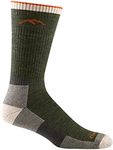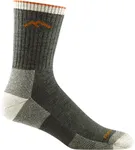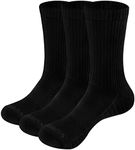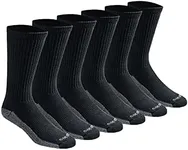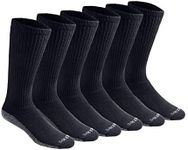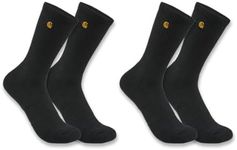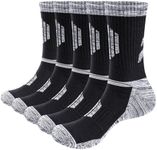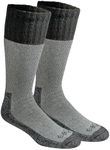Buying Guide for the Best Work Boot Socks
Choosing the right work boot socks is essential for comfort, durability, and overall foot health, especially if you spend long hours on your feet. The right pair of socks can prevent blisters, keep your feet dry, and provide the necessary support. Here are some key specifications to consider when selecting work boot socks and how to choose the best fit for your needs.MaterialThe material of the socks is crucial as it affects comfort, breathability, and moisture-wicking properties. Common materials include cotton, wool, and synthetic blends. Cotton is soft and breathable but not the best at wicking moisture. Wool is excellent for warmth and moisture-wicking but can be too warm for some environments. Synthetic blends often combine the best properties of both, offering durability, moisture control, and comfort. Choose a material based on your work environment and personal comfort preferences.
CushioningCushioning in work boot socks provides extra comfort and reduces foot fatigue. Socks can have varying levels of cushioning, from light to heavy. Light cushioning is suitable for those who prefer a more minimal feel and work in less demanding environments. Medium cushioning offers a balance of comfort and support, ideal for most work conditions. Heavy cushioning provides maximum comfort and protection, perfect for long hours on hard surfaces. Consider the nature of your work and how much time you spend on your feet to determine the right level of cushioning.
Fit and SizeA proper fit is essential to prevent blisters and ensure comfort. Socks that are too tight can restrict circulation, while those that are too loose can bunch up and cause friction. Work boot socks typically come in various sizes, so refer to the sizing chart provided by the manufacturer. Look for socks with a snug fit around the heel and arch, and ensure they stay in place without slipping down. Your shoe size and foot shape will guide you in selecting the right size.
Moisture-WickingMoisture-wicking properties help keep your feet dry by drawing sweat away from the skin. This is important for preventing blisters and maintaining foot health. Socks with good moisture-wicking capabilities are often made from synthetic materials or wool. If you work in a hot or humid environment, or if your feet tend to sweat a lot, prioritize socks with excellent moisture-wicking properties to keep your feet dry and comfortable throughout the day.
DurabilityDurability is a key factor, especially if you wear work boot socks daily. Look for socks with reinforced heels and toes, as these areas are prone to wear and tear. High-quality materials and construction methods, such as double stitching, can also enhance durability. If your job involves a lot of physical activity or harsh conditions, investing in durable socks will save you money in the long run and ensure your feet are well-protected.
CompressionCompression socks provide additional support and can improve circulation, reducing foot and leg fatigue. They are particularly beneficial for those who stand for long periods or have circulation issues. Compression levels vary from mild to firm. Mild compression is suitable for general support and comfort, while firm compression is better for those with specific medical needs or who experience significant swelling. Consider your daily activities and any health concerns when choosing the level of compression.


